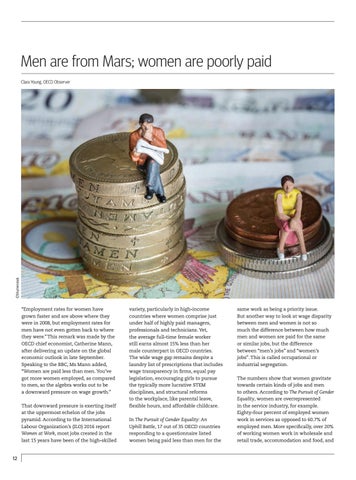Men are from Mars; women are poorly paid
©Shutterstock
Clara Young, OECD Observer
“Employment rates for women have grown faster and are above where they were in 2008, but employment rates for men have not even gotten back to where they were.” This remark was made by the OECD chief economist, Catherine Mann, after delivering an update on the global economic outlook in late September. Speaking to the BBC, Ms Mann added, “Women are paid less than men. You’ve got more women employed, as compared to men, so the algebra works out to be a downward pressure on wage growth.” That downward pressure is exerting itself at the uppermost echelon of the jobs pyramid. According to the International Labour Organization’s (ILO) 2016 report Women at Work, most jobs created in the last 15 years have been of the high-skilled
12
variety, particularly in high-income countries where women comprise just under half of highly paid managers, professionals and technicians. Yet, the average full-time female worker still earns almost 15% less than her male counterpart in OECD countries. The wide wage gap remains despite a laundry list of prescriptions that includes wage transparency in firms, equal pay legislation, encouraging girls to pursue the typically more lucrative STEM disciplines, and structural reforms to the workplace, like parental leave, flexible hours, and affordable childcare. In The Pursuit of Gender Equality: An Uphill Battle, 17 out of 35 OECD countries responding to a questionnaire listed women being paid less than men for the
same work as being a priority issue. But another way to look at wage disparity between men and women is not so much the difference between how much men and women are paid for the same or similar jobs, but the difference between “men’s jobs” and “women’s jobs”. This is called occupational or industrial segregation. The numbers show that women gravitate towards certain kinds of jobs and men to others. According to The Pursuit of Gender Equality, women are overrepresented in the service industry, for example. Eighty-four percent of employed women work in services as opposed to 60.7% of employed men. More specifically, over 20% of working women work in wholesale and retail trade, accommodation and food, and
